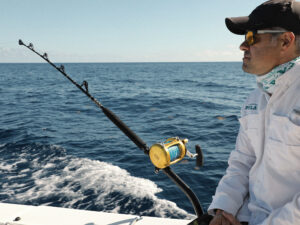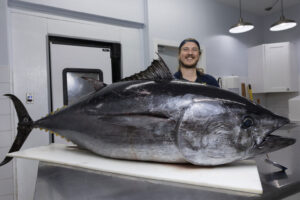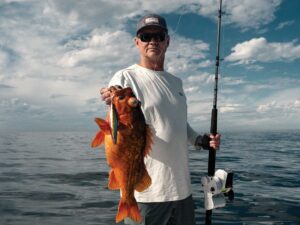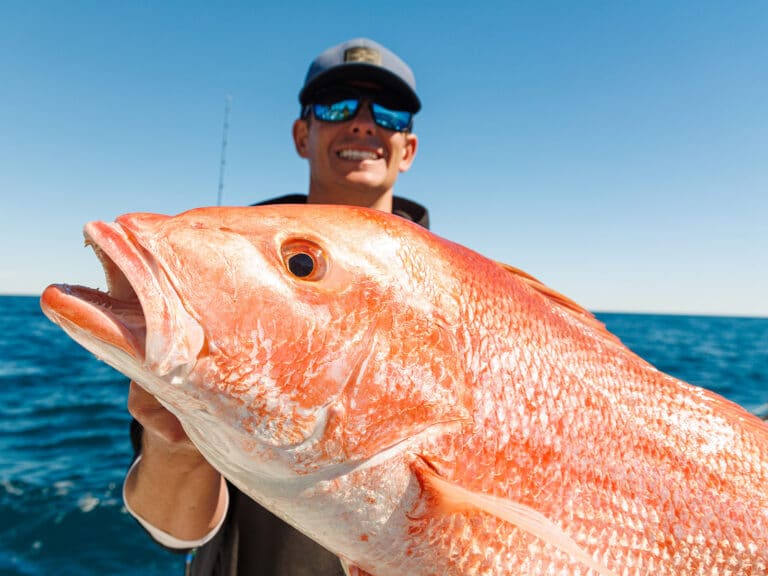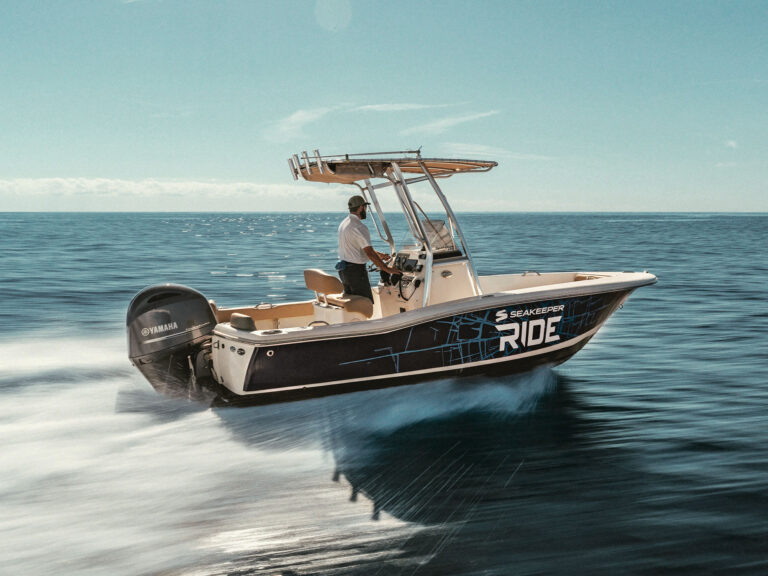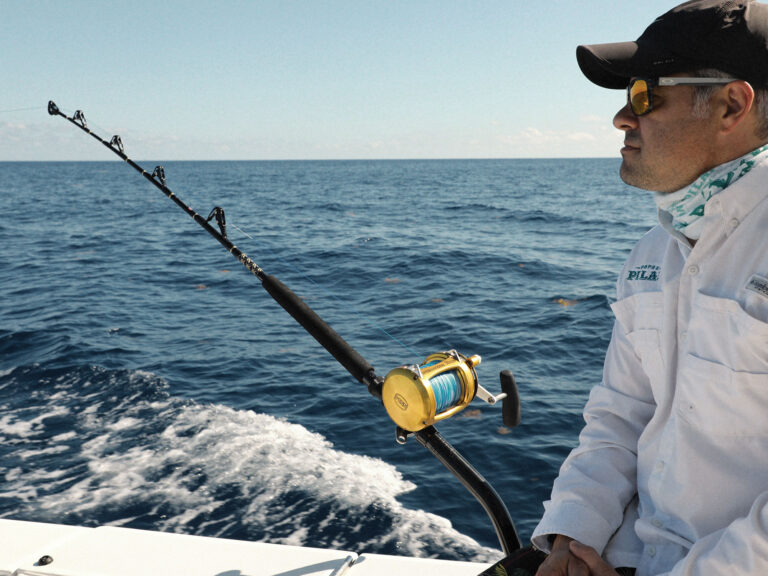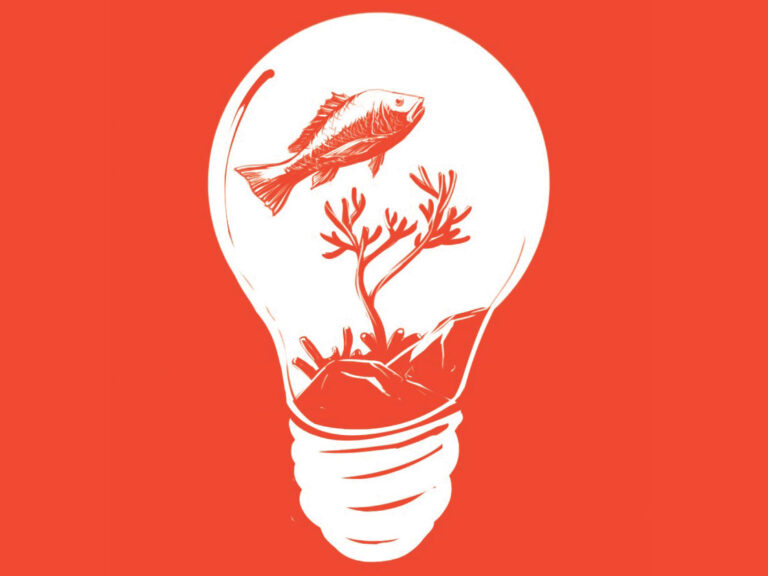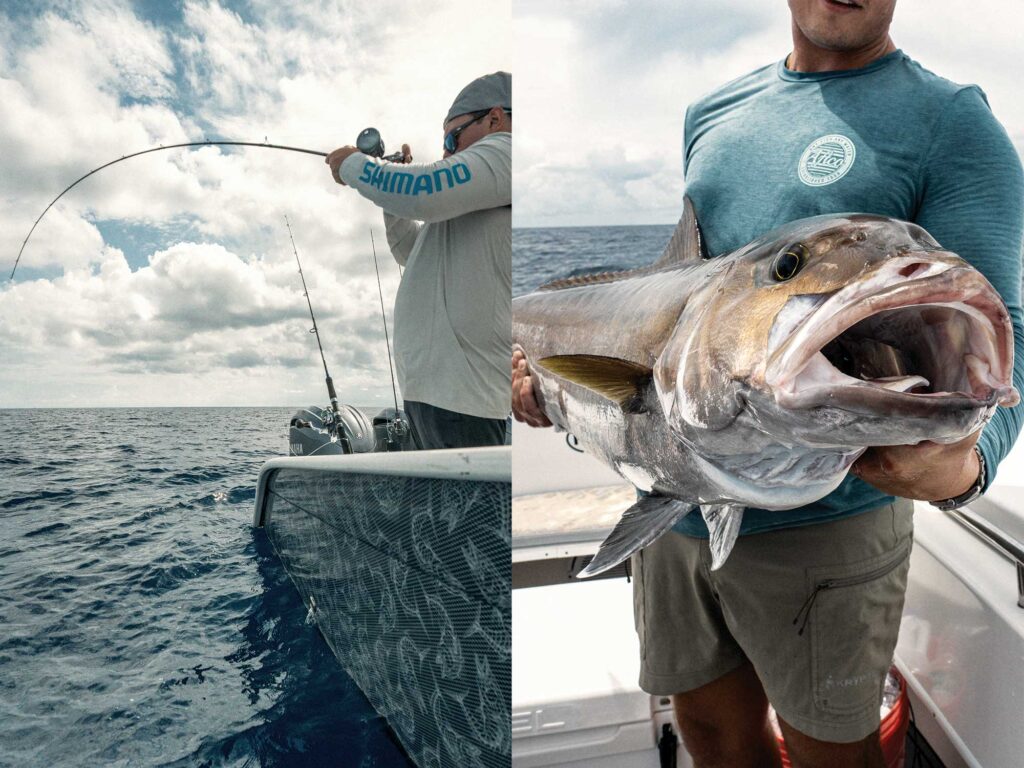
For me, slow-pitch jigging will be a totally new learning experience,” I explained to Blaine Anderson, saltwater product marketing manager for Shimano North America Fishing, as we neared the first stop of the day, an offshore structure area in 200 feet of water off the coast of Alabama.
“Don’t worry, slow-pitch jigging is pretty easy to learn,” Anderson replied. “Newcomers pick it up quickly, especially once they start catching fish.”
With that in mind, I took a deep breath, sidled up to the rail, and made my first vertical drop. Once the Shimano Shimmerfall jig reached bottom, I swept the rod upward—this is where the “slow pitch” name comes from—just as Anderson had coached me.
But then there was a problem, or so I thought. The line went slack. “Quick, start reeling!” Anderson exclaimed after noticing my bewilderment. I complied. As the line grew tight, I quickly learned the main thing about slow-pitch jigging: Most bites occur when the lure is sinking.
The next thing I learned is that slow-pitch rods are not so great for fighting fish. Whatever I hooked pinned me to the rail, and all I could do was point the skinny, featherlight slow-pitch rod at the fish and try to turn the reel handle.
Eventually, my struggle paid off. After several agonizing minutes, the fish appeared like an apparition in the depths—deep color at last. My first slow-pitch victory turned out to be a greater amberjack, estimated at 40 pounds. After a few pictures, we returned it alive and well to the Gulf waters.
Training Session
This all occurred last August when Shimano hosted me and a handful of other fishing content developers to Orange Beach, Alabama, to learn more about slow-pitch jigging in deep water and the latest products from Shimano for this technique. Shimano is one of the few, if not the only, company that offers all of the major components for assembling complete slow-pitch-jigging systems, including rods, reels, line and jigs.
There was a mix of experience among the group when it came to slow pitch, from advanced to neophytes like me. It proved to be a two-day master class with evening seminars and on-water training conducted by some of the best in the field, including Anderson and Capt. Blake Brown of Southern Bend Charters based in Orange Beach. Here are the key points of what this newbie learned.
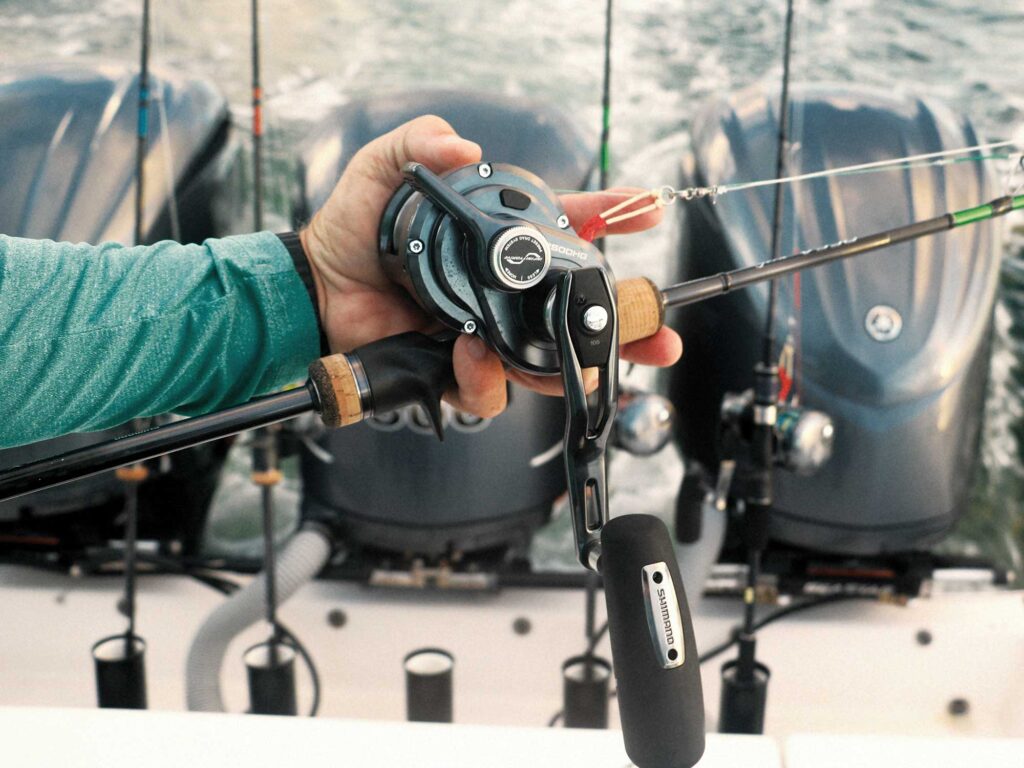
Right Rod
Having the right rod represents a key element of the slow-pitch arsenal. The softer parabolic action of these slender, lightweight rods enhances the movement of the jig during the upward sweep and allows the angler to stay in touch with the lure on the all-important downstroke without impeding its enticing flutter.
Shimano has perfected the slow-pitch action and sensitivity in its new Ocea Jigger Infinity Motive series, which includes four 6-foot-10-inch conventional trigger models for deepwater fishing. They range from medium-light to heavy for jigs ranging from 120 to 500 grams.
Each of these super-sensitive models utilizes Shimano’s proprietary Spiral X Core technology with Toray Nanoalloy to boost torsional and compressional rigidity—important strength factors with rods that are so light and slender. X-guides help prevent line from wrapping around the rod if there’s slack line on the downstroke, and trigger-style reel seats help ensure a secure grip.
Don’t look for much of a foregrip. Because they are not designed to pump fish, these rods possess foregrips that are abbreviated.
Reel Thing
I learned that conventional reels, such as the Ocea Jigger LD 2500 for deepwater slow-pitch jigging, occupy a category all their own. For one, they’re fairly narrow and compact, and feature a smoothly contoured left side plate. This optimizes the reel for this technique, which calls for always palming the reel with your left hand whether jigging or battling a fish.
The oversize handle and grip represent another key combination of features, lending not only leverage to wind in a big fish, but also a secure grip on the overall outfit while fighting a fish.
This lever-drag reel offers a maximum 44 pounds of drag, which is immense, especially given its compact 24.3-ounce size. Without such smooth braking power, we most certainly would not have stopped some of the big AJs, grouper and other fish we hooked in the deep offshore waters of Alabama.
Gear ratios can prove critical after hooking a powerful fish on slow-pitch gear, and for that reason Shimano’s Ocea Jigger LD 2500 is offered in two retrieve ratios. With the HG (6.2-to-1 ratio), anglers can retrieve jigs quickly from deep water. Yet the MG (5.7-to-1 ratio) is ideal for anglers wanting more winding power for battling big fish. I found the MG version more to my liking, especially after battling several big fish in deep water.
Line and Leader
Our reels were spooled with 30-pound-test PowerPro Maxcuatro braided line. Its thin diameter increased the line capacity of the Ocea Jigger LD 2500 versus heavier braid and minimized drag in the water column, allowing us to fish as vertically as possible. And, of course, the braid provided outstanding sensitivity for feeling subtle bites as the lure was sinking.
The 30-pound-test proved plenty strong, even for largest of the AJs, as well as big red snapper, gag grouper and other species that fell victim to the slow-pitch-jigging technique.
Anderson rigged each outfit with a 6- to 8-foot top shot of 80-pound-test fluorocarbon leader material using an RP knot, which Anderson tied with amazing speed. Unlike other fluoro-to-braid splices, such as a uni-to-uni knot, the RP knot refused to hang up, always sliding smoothly in and out of the rod guides. The abrasion resistance of the heavier fluoro helps prevent cutoffs on the sharp deepwater structure edges that Brown was targeting. At the end of the leader, Anderson tied on a 110-pound-test black barrel swivel.
Read Next: How to Slow-Pitch Jig
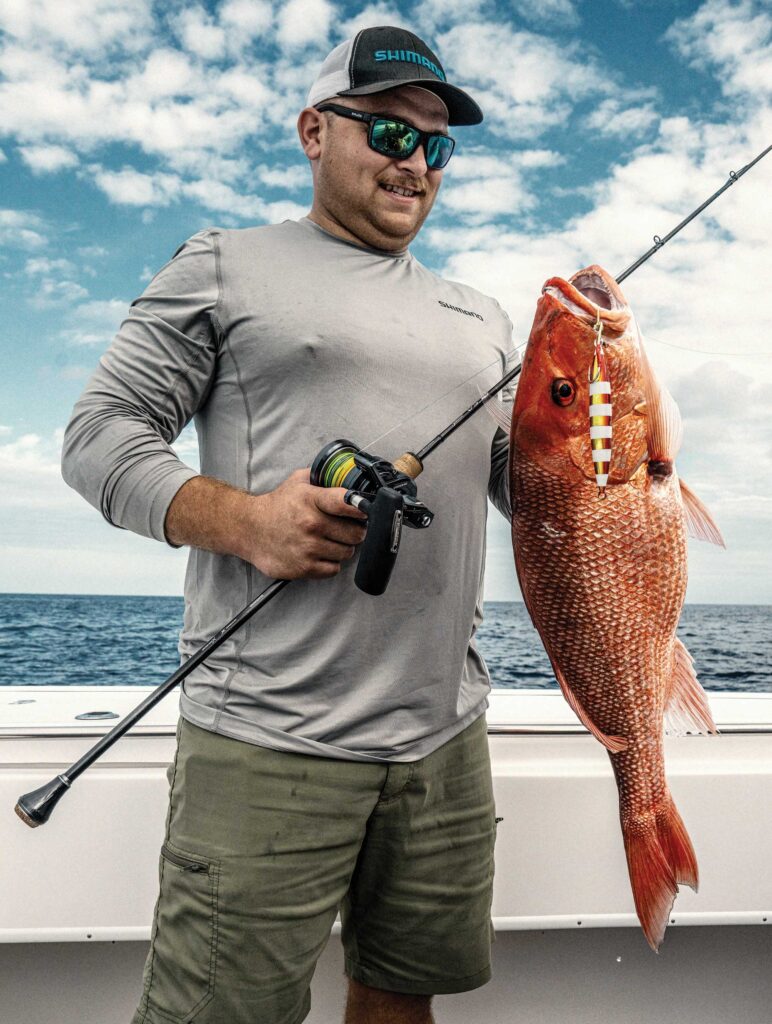
Weight and Shape
Our group of anglers fished a full selection of Shimano slow-pitch jigs to determine which one produced. The extensive lure arsenal included the Ocea Stinger Sardine Waver, Butterfly Flat Side, Butterfly Wing Fall and the Shimmerfall in a wide range of colors and patterns.
Full disclosure: All the jigs caught fish. But in my experience on this trip, the Ocea Stinger and Shimmerfall jigs seemed to produce the best, especially as Brown eased farther offshore to drift-fish structure spots at greater depths—as much as 250 to 275 feet of water. Also, when the breeze picked up in the afternoon, the slimmer profile of the Shimmerfall reached bottom more quickly than lures with wider profiles, allowing me to better fish straight up and down. On the other hand, wider-profile lures like the Butterfly Flat Side and Butterfly Wing Fall offer more fluttering action, which can sometimes be the key to triggering more bites.
Selecting the best jig weight proves crucial in maintaining a vertical presentation. Much depends on the depth of the water, but choosing the best weight also hinges on forces that affect the speed of the drift, such as wind and current. A safe rule of thumb, Anderson says, “is 1 gram of jig weight per foot of water depth,” though this can change drastically depending on wind, current and the speed of the boat drift.
Not knowing the variables of wind, current and drift speed until you actually get out on the water and start fishing means that slow-pitch anglers should be prepared with a full selection of lures. This will give you an opportunity to experiment and adapt with different jig weights and shapes to find which ones produce the best on any given day, tide, time or location.
Jig Rigging
On our trip, Anderson rigged most of the jigs with two 5/0 assist hooks on a size 4 or 6 heavy-duty stainless-steel split ring, which he then attached to the eye ring at the top of the lure. He then attached the swivel at the end of the leader to the split ring.
Using top-quality split-ring pliers, Anderson can change slow-pitch jigs quickly without cutting or retying knots. He does this by removing the swivel and reattaching it to another lure rigged with twin assist hooks on a split ring. Alternatively, he can remove the split ring from a jig and reattach it (with the hooks and swivel/line still attached) to another lure.
Varying the Depth
Some of the best tricks I learned in this master class occurred when the action slowed down. This is when Anderson encouraged me to try slow-pitch jigging in different depths of the water column. Slow-pitching the lure near bottom often resulted in hooking fish such as gag grouper. Jigging 10 to 20 feet above the bottom caught the attention of species like red snapper. Sweeping the jig up and down even higher in the water column drew the attention of AJs and almaco jacks.
In addition, when the action slowed, changing the length or the rhythm of the up-and-down rod movement, or sometimes reeling several cranks upward, then free-spooling back down, would trigger that telltale slack line—an indication that a fish had grabbed the jig on the sink, and your cue to reel down to set the hook.
I discovered much and gained a great foundation in the Shimano Alabama master class. However, when it comes to deepwater slow-pitch jigging, I have much to learn. But then, isn’t that the way for all anglers, no matter how much experience they possess?

Orange Beach Experience
The waters around Orange Beach, Alabama, abound with fishing opportunities. From redfish, spotted seatrout and tarpon in the bays and bayous to amberjack, mahi, king mackerel, grouper and snapper in offshore waters, Orange Beach can please just about any angling appetite.
Speaking of appetites, Orange Beach offers a wide range of great dining venues, from the gritty vibe of the sprawling Flora-Bama beach bar, honky tonk and kick-back yacht club to more upscale experiences like Zeke’s Restaurant at Zeke’s Landing and Marina on the shores of Cotton Bayou. There are also many restaurants with casual dining for families, such as King Neptune’s Seafood Restaurant.
Hotel and vacation rental accommodations abound in Orange Beach. Our crew stayed in a beautiful six-room condominium overlooking the water at the Brett-Robinson Vacation Rental Phoenix on the Bay condo complex in Orange Beach.
You’ll also find plenty of fishing charter boats and guides, including Southern Bend Charters (southernbendcharters.com) with whom we fished. Capt. Blake Brown can introduce you to some of the best deepwater fishing the Gulf has to offer. To learn more about Orange Beach, visit gulfshores.com.

